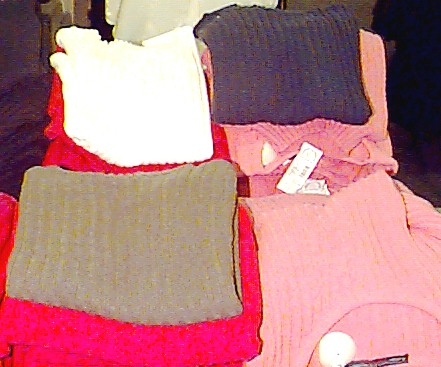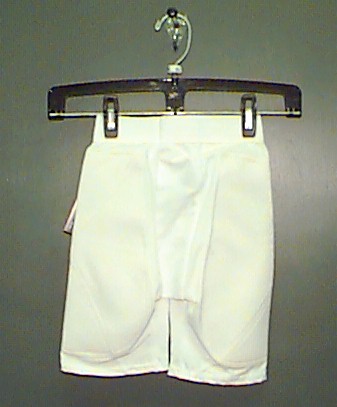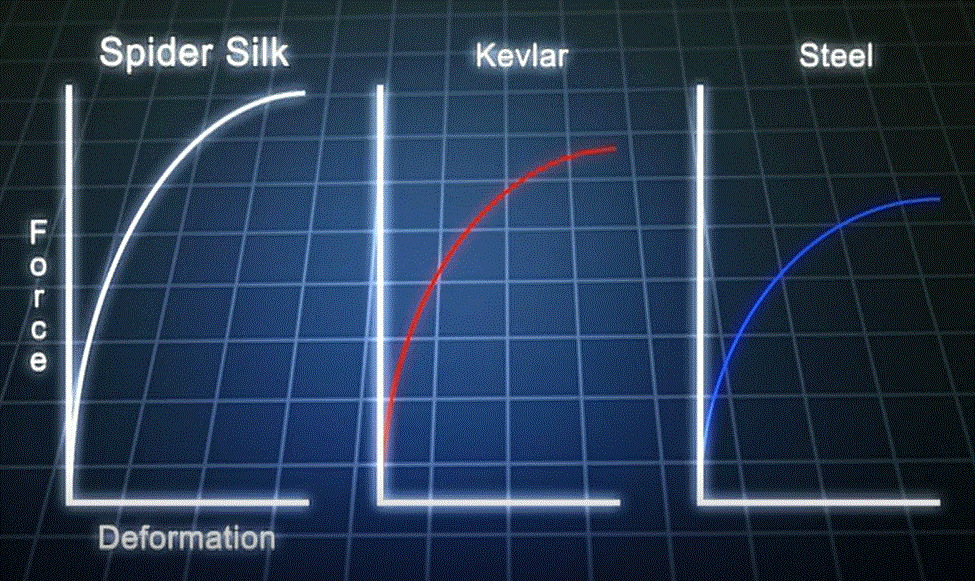
Just take a stroll through here, and you'll realize that without polymers, you'd have no clothes at all (!) let alone the quality merchandise found here. The polymers in clothes can come from plant materials, synthetics, or even proteins like silk and wool. The one thing that most of the polymers in clothes have in common is that they are fibers.
 First of all, these blue jeans and t-shirts are made of cotton, which is mostly cellulose.
First of all, these blue jeans and t-shirts are made of cotton, which is mostly cellulose.

Sweaters like these can be made from wool, which is a protein called keratin. So is your hair and fingernails, by the way. Sweaters can also be made out of acrylics, like polyacrylonitrile or
RayonTM.
Socks are made out of a lot of the same polymers as sweaters. Plus, you'll also find polymers like nylon (which feels horrible on your skin) and cotton, which is made of cellulose. Cotton is unique in that it has great "hand," the term textile engineers use to describe that
just feels good in your hand. Also, to keep them from falling down, socks sometimes have a little bit of SpandexTM in them.


 SpandexTM is a special kind of polyurethane that's very stretchy. SpandexTM is also used in bicycle pants, swimsuits, and other items of stretchwear. While it is very stretchy, it's also very tough, which means you have to pull really hard on it
to break it. And that's why some people (who probably shouldn't) manage to squeeze themselves into spandex two sizes too small. Ugh!
SpandexTM is a special kind of polyurethane that's very stretchy. SpandexTM is also used in bicycle pants, swimsuits, and other items of stretchwear. While it is very stretchy, it's also very tough, which means you have to pull really hard on it
to break it. And that's why some people (who probably shouldn't) manage to squeeze themselves into spandex two sizes too small. Ugh!
These are examples of polyester retrowear. It's popular among kids who were too young to remember how horrible it really was to live during the tasteless seventies. Hopefully this stuff will soon have gone out of style TWICE. This kind of clothing is often made of polyester although nylon has also been used. As single polymer fabrics, these make the clothes slick and slimy feeling on the skin. Not a good thing, even though my mother loved the idea of "no-iron" clothes.

All of the clothing here is made of polymers in the form of fibers. Just to remind you, clothing fibers are almost always made by spinning from molten polymer, and that means the polymer must have a melting point below its decomposition temperature. That's one reason Kevlar and other aramid polymers are so expensive- they don't melt so they have to be spun from very special solvents and that costs money. Cloth made from aramids is often called "bullet proof," but that's not really correct. Better to say they're bullet resistant.

Now for an interesting comparison of synthetic and natural polymer fibers to steel. Kevlar, of course, is one of the most high strength fibers we make today. It's stronger than a steel fiber if you compare tensile strengths as in the plot below. But hold your horses! Nature not only beat us to the punch in making fibers but makes them stronger than we can. We're talking about spider silk (more about that later). It's tensile strength is actually higher than either steel or Kevlar. Wonder of all wonders. Now the trick is to figure out how and why so we can make our synthetic fibers even better.
And now for the modern garments made of micro-fibers! Not a lot to say, really, other than the fibers are smaller in diameter than those of regular cloth. Big deal, you say. Well, it feels different, and more important, it wicks away moisture (ok, yeah, we're talking about sweat). That's important in areas where you might get a rash you really don't want to scratch in public. Hence, new names for fabrics and new names for clothes they're made of, such as "Under Armament" or some such. Once one company figured out that the public would pay a premium for these clothes, everybody pretty much jumped on the bandwagon, so now you can get generics that work almost as well as the original premium products.

|
Return to Level One Directory |

|
Return to Macrogalleria Directory |